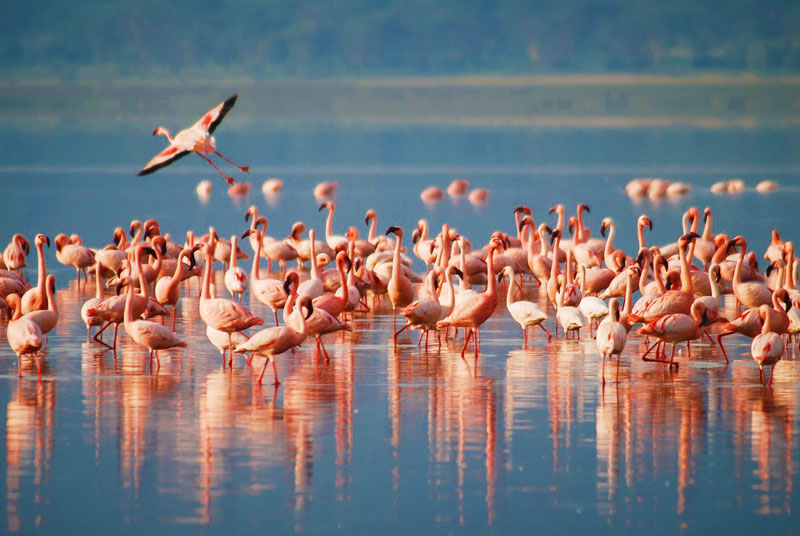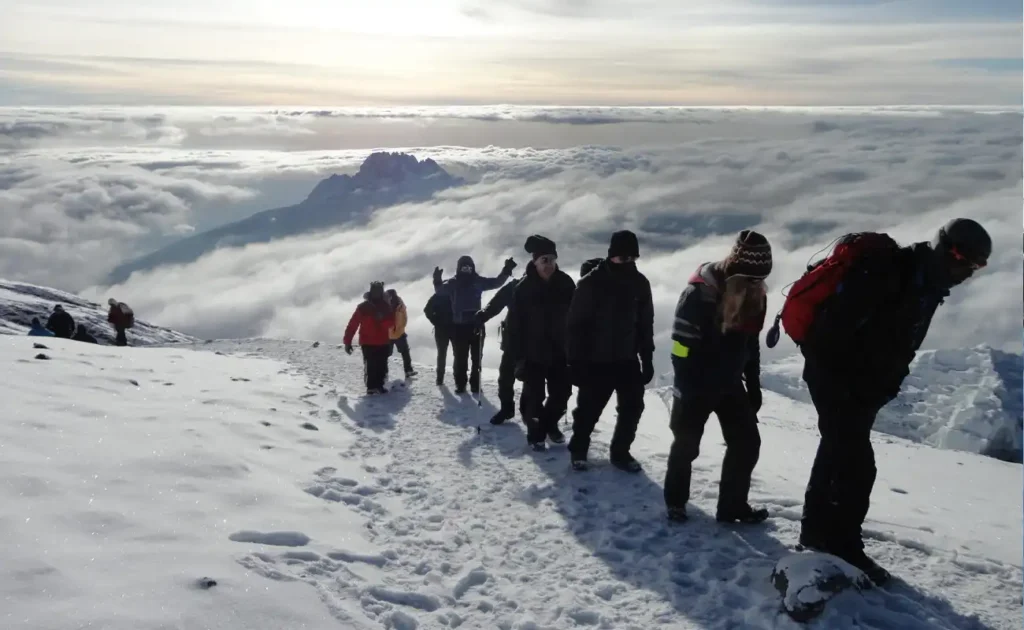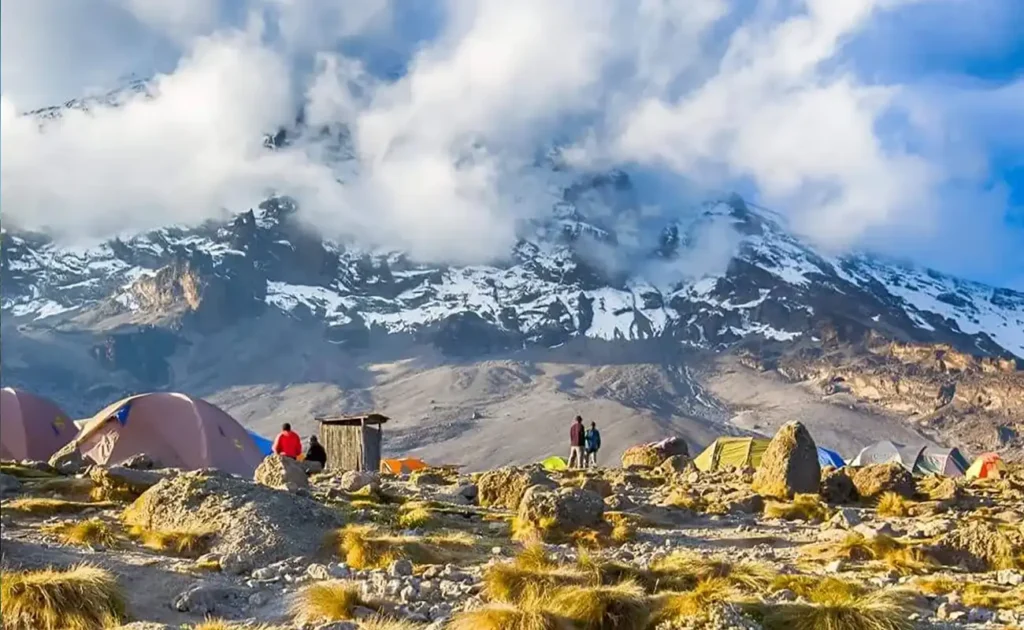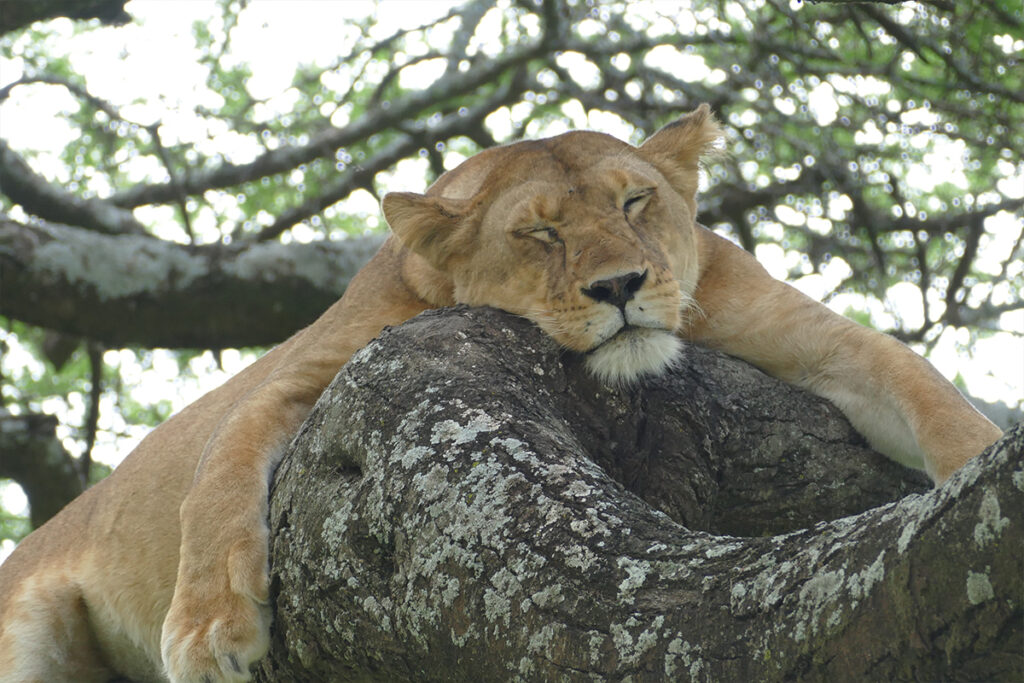Lake Manyara, nestled at the base of the Great Rift Valley escarpment, hosts thousands of flamingos every year. These birds transform the lake into a surreal pink spectacle, a fascinating sight for onlookers and researchers alike. The sheer number of flamingos is not just visually stunning but also an indication of the lake’s unique ecosystem.
Historically, Lake Manyara has been a sanctuary for these migratory birds, primarily Lesser Flamingos. The lake’s alkaline waters are rich in cyanobacteria, which serve as the primary food source for the flamingos. Notably, this lake plays a critical role in supporting nearly a million flamingos during peak season, showcasing its ecological significance.

Flamingos Lake Manyara
Lake Manyara in Tanzania is home to one of the most remarkable flamingo populations in the world. Visitors often flock to see thousands of these elegant birds creating a shimmering pink hue over the water. This lake serves as a vital stop for migratory flamingos, attracting them with its abundant food supply. The water contains high levels of algae, providing a rich feeding ground for these birds. In fact, the dense concentration of flamingos is not just a visual treat but also an ecological indicator of the lake’s health.
The serene beauty of Lake Manyara makes it an ideal setting for unique experiences. According to this post, the area offers walking safaris, allowing visitors to enjoy the site up close. Such activities provide an opportunity to appreciate not only the flamingo population but also the diverse wildlife inhabiting the shores. Alongside flamingos, the lake is frequented by hippos, baboons, and various bird species. These experiences enhance the fascination and understanding of the lake’s vibrant ecosystem.
Preserving this breathtaking habitat is crucial for maintaining its natural beauty and biodiversity. Over the years, Lake Manyara has faced challenges from environmental changes and human activities. Conservationists have been working tirelessly to protect the area and reduce the impact of surrounding agriculture. Local initiatives aim to balance ecological needs with tourism, ensuring both the wildlife and local communities benefit. Continued efforts will help maintain Lake Manyara as a sanctuary for flamingos and other species.
For those looking for a more relaxing visit, many accommodations offer panoramic views of the lake. Enjoying a stay at a lodge provides easy access to the park’s peaceful environment. Here is an article offering additional details about such experiences, like the “best view lodge,” which is popular among tourists. By staying nearby, visitors can immerse themselves in the natural wonders of Lake Manyara from sunrise to sunset. This combination of rest and exploration promises to create unforgettable memories.
The Ecological Importance of Lake Manyara
Lake Manyara is more than just a picturesque body of water; it plays a crucial role in the regional ecosystem. It supports a wide array of wildlife, providing a habitat for birds, mammals, and aquatic species. The lake’s alkaline waters are rich in minerals, fostering the growth of algae which serves as food for flamingos and other waterfowl. This beneficial relationship helps maintain Lake Manyara’s biodiversity. Additionally, the surrounding forests and wetlands serve as important areas for animals seeking refuge and breeding grounds.
In addition to its role as a wildlife haven, Lake Manyara contributes significantly to local communities. It provides water for agriculture, supporting farmers who live nearby. The fertile lands around the lake facilitate the growth of crops, contributing to the local economy. Moreover, tourism linked to the lake generates income and employment opportunities. People come from all over to witness the stunning landscapes and thriving wildlife, boosting the area’s economic development.
Efforts to preserve the ecological balance of Lake Manyara are ongoing, incorporating both conservation strategies and community involvement. Programs aim to protect the delicate environment from threats like deforestation and pollution. Local organizations collaborate to promote sustainable practices that benefit both nature and humans. This includes educating the public about the importance of safeguarding natural habitats. By working together, these initiatives strive to support the lake’s vibrant ecosystem.
The lake’s diverse flora and fauna also contribute to scientific understanding and research. Studies conducted in and around Lake Manyara contribute to knowledge about ecological dynamics and environmental changes. The unique mix of species offers insights into adaptation and survival strategies. Researchers and students alike benefit from the wealth of information the area provides. These aspects make Lake Manyara not just an ecological treasure, but also a valuable resource for learning and discovery.
Flamingo Migration Patterns and Seasonal Variations
Flamingos at Lake Manyara are well-known for their fascinating migration patterns. They travel great distances to find suitable conditions for feeding and breeding. During the dry season, water levels drop, altering the habitat significantly. These changes can trigger flamingos to migrate to alternative lakes in East Africa. Their movement is a natural response to the ecological shifts, showcasing the adaptability of these remarkable birds.
Seasonal variations at Lake Manyara greatly influence the behaviors of flamingos. In the wet season, when the lake swells with rainwater, it becomes a thriving hub for feeding. The abundance of algae and small organisms attracts large flocks. This period offers not only food resources but also safe nesting grounds. During these times, flamingos are most visible, turning the area into a bustling pink paradise.
Migration is critical for the survival of flamingos, enabling them to access different resources throughout the year. The distance they travel can vary, sometimes covering hundreds of kilometers. Successful migration ensures they find not just food but also ideal conditions for rearing their young. Safeguarding these migration routes is essential for their continued survival. Conservationists focus on protecting key habitats along these paths.
Tracking these migration patterns aids researchers in understanding flamingo behavior and ecosystem health. Scientists use techniques like banding and satellite tracking to monitor their journeys. Information gathered helps predict future movements and manage conservation efforts effectively. These studies contribute valuable data to broader ecological understanding. The knowledge gained underscores the complex interactions between wildlife and their environments.
Role of Alkaline Water in Flamingo’s Diet
The alkaline water of Lake Manyara is crucial for the diet of flamingos. These birds favor environments where the water is rich in minerals and has a high pH level. Such conditions promote the growth of cyanobacteria and algae, which are primary food sources for flamingos. The presence of these microorganisms in the alkaline water provides the necessary nutrients for flamingos to thrive. This relationship underscores the importance of maintaining the lake’s unique water chemistry.
Flamingos use their specially adapted beaks to filter-feed on the microscopic organisms in the water. They sweep their heads side to side, trapping algae and bacteria in their comb-like structures called lamellae. This efficient feeding method allows them to consume large quantities of food quickly. The high nutrient content in alkaline water supports their energy needs and vibrant plumage. The distinctive pink color of flamingos comes from pigments called carotenoids found in their diet.
Lake Manyara’s alkaline waters create an ideal breeding ground for flamingos. During the breeding season, the abundance of food helps ensure the survival of chicks. Parent flamingos regurgitate partially digested food for their young, providing them with essential nutrients. This diet of cyanobacteria and algae is vital for the rapid growth and development of chicks. Adequate food supply during this period increases the chances of successful breeding.
Changes in water quality can significantly impact the flamingo population. Pollution, climate change, and human activities pose threats to the delicate balance of the lake’s ecosystem. Efforts to monitor and preserve the water quality are essential. Local and international conservation programs aim to protect these crucial habitats. By safeguarding the alkaline environment, we help sustain the flamingo populations that rely on Lake Manyara for nourishment.
The role of alkaline water in the diet of flamingos exemplifies the intricate connections within natural ecosystems. Maintaining the health of Lake Manyara benefits not just flamingos but a diversity of species that depend on the lake. The interdependence between water quality, food availability, and wildlife highlights the need for conservation. Protecting natural habitats ensures that these wondrous birds can continue to grace the skies and waters of Lake Manyara.
Challenges Facing Flamingos at Lake Manyara
Despite their breathtaking presence, flamingos at Lake Manyara encounter several challenges. Pollution is one of the most pressing issues affecting the lake and its inhabitants. Agricultural runoff, containing pesticides and fertilizers, seeps into the water. This contamination can harm the algae and bacteria flamingos feed on. Long-term exposure to polluted water can also threaten their health, leading to decreased flamingo populations.
Climate change is another significant challenge facing flamingos at Lake Manyara. Changes in weather patterns can alter water levels, affecting the availability of food and suitable nesting sites. During extended droughts, the lake can shrink drastically, reducing the habitat for flamingos. Conversely, heavy rains may cause flooding, disrupting breeding grounds and washing away nests. These fluctuations make it harder for flamingos to find stable environments to thrive.
Human activities around Lake Manyara also pose a threat to the flamingo population. Increased tourism can lead to habitat disturbance and pollution if not managed sustainably. Infrastructure development, such as new roads and buildings, can encroach on the natural habitats of flamingos. Uncontrolled fishing and boating activities can also disrupt their feeding and breeding routines. Effective management is essential to balance tourism benefits with conservation needs.
Efforts to address these challenges are underway through various conservation programs. Community education plays a key role in promoting sustainable practices. Initiatives like creating buffer zones between farms and the lake help reduce pollution. There are also projects aimed at conserving water resources to maintain stable lake levels. Collaboration between local communities, governments, and international organizations is crucial for the success of these efforts.
Protecting the flamingos at Lake Manyara requires ongoing commitment and action. Monitoring programs help track the health of the flamingo population and the lake’s ecosystem. Effective conservation strategies can mitigate the impact of human activities and climate change. By addressing these challenges, we can ensure the survival of these graceful birds and the preservation of their habitat. Continued efforts will help safeguard Lake Manyara for future generations.
Conservation Efforts to Protect the Flamingo Population
Conservation efforts at Lake Manyara focus on preserving the habitat and ensuring the long-term survival of the flamingo population. A significant part of these efforts includes monitoring water quality to maintain a healthy ecosystem. Regular testing helps detect pollution levels, allowing for prompt action to protect the lake’s delicate balance. By keeping the water clean, these efforts ensure that flamingos have a safe and nutritious food source. This proactive approach is crucial for sustaining both flamingos and other wildlife dependent on the lake.
Effective conservation also involves habitat restoration projects. These initiatives work to repair degraded areas, making them suitable for wildlife once more. Planting vegetation around the lake helps prevent erosion, stabilize the shoreline, and improve water quality. Such measures create better breeding and feeding grounds for flamingos. Reforesting areas near the lake also provides additional habitats for other species, contributing to the overall biodiversity.
Community engagement is vital for the success of conservation programs. Local communities play an active role in safeguarding Lake Manyara and its inhabitants. Educational campaigns raise awareness about the importance of protecting natural habitats. People are encouraged to adopt sustainable farming practices that minimize pollution. Community-led initiatives, such as clean-up projects and tree planting, foster a sense of responsibility and ownership over local resources.
Collaborative efforts between various stakeholders enhance the effectiveness of conservation strategies. Governments, non-governmental organizations, and research institutions work together on policy development and implementation. These collaborations bring together expertise and resources, amplifying the impact of conservation actions. Joint research projects help identify new challenges and create innovative solutions. By working together, these groups can achieve more significant results in protecting the flamingo population.
Sustainable tourism is another key element in conservation efforts. Proper management ensures that tourism activities do not harm the flamingos or their habitat. Guidelines and regulations help control visitor numbers and activities within the park. Eco-friendly accommodations and tours promote environmental awareness among tourists. Revenue generated from tourism supports conservation projects, creating an economic incentive for preservation.
Long-term conservation plans are essential for addressing future threats and ensuring the ongoing protection of Lake Manyara’s flamingos. These plans include monitoring climate change impacts and developing adaptive strategies. Building resilience within the ecosystem prepares it for potential environmental changes. By planning for the future, conservationists can safeguard this unique habitat for generations to come. Commitment to these efforts is key to the continued survival of the flamingo population at Lake Manyara.

Frequently Asked Questions
Explore the fascinating world of flamingos at Lake Manyara, a key habitat for these elegant birds. Discover answers to common questions about their behavior, habitat, and ecological impact.
1. Why is Lake Manyara a popular habitat for flamingos?
Lake Manyara provides the perfect conditions for flamingos, thanks to its alkaline waters. These waters are rich in microorganisms like algae and plankton, which are the primary food sources for flamingos. The abundance of food here allows large flocks to thrive, especially during the breeding season.
The lake’s sheltered environment also offers protection from predators, making it an ideal breeding ground. During the wet season, rising water levels create safe nesting sites on small islands. These natural features contribute to the high concentration of flamingos at Lake Manyara.
2. What challenges do flamingos face at Lake Manyara?
Flamingos at Lake Manyara face several environmental and human-induced challenges. Climate change can alter water levels, affecting food availability and nesting sites. During droughts, the lake may shrink, leading to reduced habitat for the flamingos.
Human activities like agriculture and tourism introduce pollutants into the lake, threatening the ecosystem. Conserving this habitat requires efforts to balance human use with wildlife needs. Protecting water quality and managing land use are essential strategies for overcoming these challenges.
3. How do flamingos benefit the ecosystem of Lake Manyara?
Flamingos play a vital role in maintaining the ecological balance of Lake Manyara. By feeding on algae and plankton, they help regulate these populations, preventing overgrowth that could harm water quality. This feeding activity supports a healthier ecosystem for all aquatic life.
Moreover, flamingos contribute to nutrient cycling within the lake. Their droppings serve as fertilizer, enriching the water with essential minerals. This boosts plant life, providing a food base for other creatures, enhancing biodiversity and ecosystem health.
4. What conservation efforts are in place to protect flamingos at Lake Manyara?
Various conservation initiatives are underway to safeguard the flamingos of Lake Manyara. These include monitoring water quality to prevent pollution and implementing habitat restoration projects to maintain suitable conditions. Efforts also focus on promoting sustainable tourism to minimize habitat disruption.
Community involvement plays a crucial role, with local education programs raising awareness about the significance of conservation. Collaboration between stakeholders enhances the effectiveness of these strategies, ensuring the sustainable protection of both flamingos and their environment.
5. How can visitors responsibly enjoy the flamingo spectacle at Lake Manyara?
Visitors can enjoy the flamingo spectacle responsibly by adhering to park guidelines and respecting wildlife. This includes keeping a safe distance from the birds to avoid disturbing their natural behavior. Using eco-friendly tour providers can also minimize environmental impact.
Opting for guided tours ensures that tourists receive educational insights while preserving the habitat. Contributing to local conservation efforts or participating in clean-up initiatives enhances experiences and supports ongoing preservation actions for Lake Manyara.



